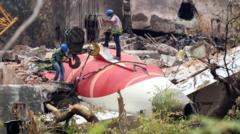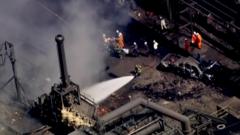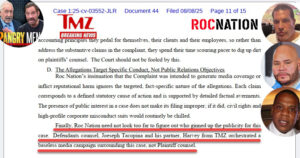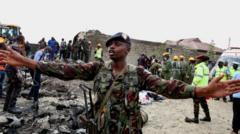Families continue to grieve as authorities work to identify victims and uncover the truth behind the tragedy.
Air India Flight Crash: Cockpit Voice Recorder Recovered in Investigation Efforts

Air India Flight Crash: Cockpit Voice Recorder Recovered in Investigation Efforts
The recovery of the cockpit voice recorder marks a significant development in understanding the cause of last week’s deadly Air India crash.
Investigators have successfully retrieved the cockpit voice recorder (CVR) from the wreckage of the Air India flight that tragically crashed shortly after takeoff. This crucial element of the investigation will aid in determining the causes behind last Thursday's disaster, which took the lives of at least 270 individuals, primarily passengers of the ill-fated London-bound flight.
The Air India aircraft, a Boeing 787-8 Dreamliner, went down seconds after leaving Ahmedabad, India. The CVR records cockpit conversations, alarms, and other ambient sounds, providing vital context to the flight's final moments. Coupled with the flight data recorder (FDR), painstakingly extracted from the debris, both instruments—often referred to as "black boxes," despite their bright orange color—are pivotal tools for air crash investigations.
India’s Aircraft Accident Investigation Bureau (AAIB) spearheads the inquiry with collaborative efforts from the United States National Transportation Safety Board (NTSB) and teams from both Boeing and the Federal Aviation Administration (FAA). A comprehensive investigation is underway, and a specialized Indian government committee is set to convene shortly, aiming to generate new standard operating procedures to prevent future incidents.
As officials work on the investigation, families are increasingly overwhelmed with grief and uncertainty. Less than a minute after takeoff, Flight AI171 collided with a building housing medical personnel from the BJ Medical College and Civil Hospital. For the families of the deceased, the slow process of DNA identification has intensified their anguish.
Over the weekend, medical professionals reported the recovery of 270 bodies, with more than 90 already identified. Among the confirmed victims is Vijay Rupani, the former chief minister of Gujarat, who will be honored with a state funeral. However, many families are still left in limbo, waiting for closure as identifying the more severely burned victims poses significant challenges.
One anxious relative, Mistry Jignesh, expressed his despair over the slow identification process, emphasizing the emotional toll on families still searching for missing loved ones. He stated, “When people are still missing, how can they complete the DNA process by tomorrow? The wait is killing us.”
As the community grapples with the aftermath of the crash, authorities remain committed to uncovering the truth behind this devastating incident.
The Air India aircraft, a Boeing 787-8 Dreamliner, went down seconds after leaving Ahmedabad, India. The CVR records cockpit conversations, alarms, and other ambient sounds, providing vital context to the flight's final moments. Coupled with the flight data recorder (FDR), painstakingly extracted from the debris, both instruments—often referred to as "black boxes," despite their bright orange color—are pivotal tools for air crash investigations.
India’s Aircraft Accident Investigation Bureau (AAIB) spearheads the inquiry with collaborative efforts from the United States National Transportation Safety Board (NTSB) and teams from both Boeing and the Federal Aviation Administration (FAA). A comprehensive investigation is underway, and a specialized Indian government committee is set to convene shortly, aiming to generate new standard operating procedures to prevent future incidents.
As officials work on the investigation, families are increasingly overwhelmed with grief and uncertainty. Less than a minute after takeoff, Flight AI171 collided with a building housing medical personnel from the BJ Medical College and Civil Hospital. For the families of the deceased, the slow process of DNA identification has intensified their anguish.
Over the weekend, medical professionals reported the recovery of 270 bodies, with more than 90 already identified. Among the confirmed victims is Vijay Rupani, the former chief minister of Gujarat, who will be honored with a state funeral. However, many families are still left in limbo, waiting for closure as identifying the more severely burned victims poses significant challenges.
One anxious relative, Mistry Jignesh, expressed his despair over the slow identification process, emphasizing the emotional toll on families still searching for missing loved ones. He stated, “When people are still missing, how can they complete the DNA process by tomorrow? The wait is killing us.”
As the community grapples with the aftermath of the crash, authorities remain committed to uncovering the truth behind this devastating incident.



















